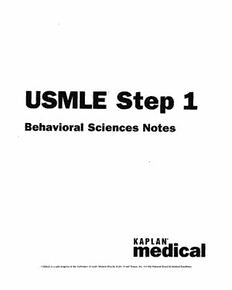
Kaplan Medical USMLE Step 1 Lecture Notes: Behavioral Sciences PDF
Preview Kaplan Medical USMLE Step 1 Lecture Notes: Behavioral Sciences
Step 1 USMLE' Behavioral Sciences Notes - : J KAPLAN@. me dIca I *USMLEisajointprogramofthe FederationofState MedicalBoardsofthe UnitedStates, Inc.andthe NationalBoardofMedicalExaminers. l I @2002Kaplan, Inc. Allrights reserved.Nopart ofthisbook maybe reproduced in anyform, byphotostat, microfilm,xerographyoranyothermeans, orincorporated into anyinformation retrievalsystem,electronicormechanical,without tbe writtenpermissionofKaplanI,nc. AuthorandExecutiveEditor StevenR.Daugherty, Ph.D. Director ofEducation and Testing Kaplan Medical Rush Medical College Chicago, IL Contributor Alina Gonzalez-Mayo,Ph.D. Psychiatrist ExecutivDeirectorofCurriculum RichardFriedland,M.D. DirectorofPublishinagndMedia MichelleCovello ManagingEditor Kathlyn McGreevy ProductionEditor Ruthie Nussbaum ProductionArtist MichaelWolff CoverDesign Joanna Myllo CoverArt RichLaRocco Tableof Contents Preface. ............................. .........................vii Chapter1:Epidemiology 1 Chapter 2: Statistics. ............................................ 15 Chapter 3: Sociallife inthe UnitedStates. ..........................39 Chapter 4: Substance Abuse. ................................ .....49 Chapter 5: Human Sexuality. ................. .............. ......59 Chapter 6: Learningand BehaviorModification. ......................73 Chapter 7: Defense Mechanisms. .................... .............83 Chapter 8: PsychologicHealthand Testing. ..........................97 Chapter 9: ChildDevelopment...... ........ .... ..... .. ..... ... .. 103 Chapter 10: SleepandSleepDisorders........................... .. 121 Chapter 11:Physician-PatienRtelationships. ........................ 131 Chapter 12:Diagnosticand StatisticalManual IV(DSMIV) 141 Chapter 13:OrganicDisorders. .................................. 169 Chapter 14: Psychopharmacology.................... ....... ...... 181 Chapter 15:Ethicaland Legal Issues ...............................197 N.' mKAPeLAd lea I v I I I l I I I Preface Thesesevenvolumes of Lecture Notes represent a yearlong effort on the part of the Kaplan Medicalfacultytoupdate our curriculum toreflectthe most-likely-to-be-tested materialonthe current USMLEStep1exam. Pleasenote that theseareLectureNotes,not reviewbooks. The Notes were designed to be accompanied by faculty lectures-live, on video, or on the web. Readingthese Notes without accessingthe accompanying lectures is not an effectiveway to reviewforthe USMLE. Tomaximizethe effectivenessoftheseNotes,annotate them asyoulistento lectures. Tofacil- itate this process, we've created wide, blank margins. While these margins are occasionally punctuated byfacultyhigh-yield"margin notes:' theyare,forthe most part, leftblank foryour notations. Manystudents findthat previewingtheNotes prior tothe lecture isaveryeffectivewaytopre- pareforclass. Thisallowsyoutoanticipate the areaswhereyou'llneed topayparticular atten- tion. It alsoaffordsyou the opportunity to map out how the information isgoing tobe pre- sentedand what sort of studyaids (charts,diagrams, etc.)you might want to add.Thisstrate- gyworksregardlessofwhether you're attending alivelecture orwatching one onvideo or the web. Finally,wewant tohearwhatyouthink. What doyoulikeabout thenotes? Whatdoyouthink couldbe improved? Pleaseshareyour [email protected]. Thankyouforjoining KaplanMedical,and best ofluckonyour Step1exam! KaplanMedical '. KmAPeLAiNIlea I vii ~ -- -u- - ------- u -u ~---~ Epidemiology Epidemiologyisthe study ofthe distribution and determinants ofhealth-related stateswithin Note apopulation. . TheUSMlERequiresYouto Epidemiologyseesdiseaseasdistributed within agroup, not asaproperty ofan indi- Know: vidual. . . Thedefinitionsanduseof Thetools ofepidemiologyarenumbers. Numbers in epidemiology areratios convert- rates edinto rates. . . Thedenominator iskey:whois"atrisk"foraparticular eventor diseasestate. Incidence and prevalence . . Ratesaregenerally,but not always,per 100,000bythe Centers for DiseaseControl and Standardizedrates Prevention (CDC),but canbeper anymultiplier. . . Compare the number ofactualcaseswith the number ofpotential casesto determine Useand computations for the rate. screening tests Actual cases Numerator . = Howto identify bias in RATE Potential cases Denominator research . Common study designs A.Incidence and Prevalence 1. Incidencerate:the rateatwhichnew events occurin apopulation. The numerator is the number of NEW eventsthat occur in a defined period; the denominator isthe population atriskofexperiencing thisnew eventduring the sameperiod. Number ofnew events in aspecifiedperiod Incidence rate = "." . . . X IOn Number ofpersons exposedto nsk durmg this penod a. Attack rate: a type of incidence rate in which the denominator is further reduced forsomeknown exposure b. Focusonacuteconditions 2. Prevalencerate:allpersons who experiencean eventinapopulation. Thenumerator isALLindividuals whohavean attribute or diseaseat a particular point intime (or during aparticular period oftime);the denominator isthe population atriskofhav- ingthe attribute or diseaseatthispoint in time or midwaythrough the period. Allcasesofadiseaseatagivenpoint/period Prevalence rate = Tootalpopul'atlOn"atn.sk" atagI.venpom. t or pen.od X IOn a. Pointprevalence:prevalenceataspecifiedpoint in time - b. Periodprevalence:prevalenceduring aspecifiedperiod or spanoftime - c. Focusonchronic conditions mKAePuLAlC~.aI 1 USMLEStep 1:Behavioral Sciences d. Prevalence can be changed by simply moving the cutoff that defines what constitutes acaseofdisease. 20 Cutoff%Prevalence 90 = 25.3% 95 = 14.5% %of 15- 100 = 8.5% Screened Population 105 = 4.8% 10- 110 = 3.0% 115 = 1.5% 5- 0 50 60 70 80 90 100 110 120 130 DiastolicBloodPressure (mmHg) Figure 1-1.Prevalence ofHypertension 3. Understanding the relationship betweenincidenceand prevalence = = a. Prevalence Incidencex Duration (P Ix D) b. "Prevalencepot" i. Incident casesor newcasesaremonitored overtime. ii. Newcasesjoin pre-existing casesto makeup totalprevalence. iii. Prevalent casesleavethe prevalencepot in one of twoways:recovery or death. Incident Cases General Population at Risk 1]1 y Prevalent Mortality Cases Recovery Figure 1-2.Prevalence Pot '. 2 KmAPeLAN.. leaI
